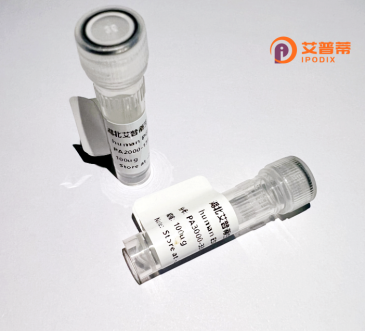
| 纯度 | >90%SDS-PAGE. |
| 种属 | Human |
| 靶点 | RGS12 |
| Uniprot No | O14924 |
| 内毒素 | < 0.01EU/μg |
| 表达宿主 | E.coli |
| 表达区间 | 1-555 aa |
| 活性数据 | MKKHDFAENLPSSLLIIILVIFTLSGSKFGRGTGLTQPSQRTSARRSFGRSKRFSITRSLDDLESATVSDGELTGADLKDCVSNNSLSSNASLPSVQSCRRLRERRVASWAVSFERLLQDPVGVRYFSDFLRKEFSEENILFWQACEYFNHVPAHDKKELSYRAREIFSKFLCSKATTPVNIDSQAQLADDVLRAPHPDMFKEQQLQIFNLMKFDSYTRFLKSPLYQECILAEVEGRALPDSQQVPSSPASKHSLGSDHSSVSTPKKLSGKSKSGRSLNEELGDEDSEKKRKGAFFSWSRTRSTGRSQKKREHGDHADDALHANGGLCRRESQGSVSSAGSLDLSEACRTLAPEKDKATKHCCIHLPDGTSCVVAVKAGFSIKDILSGLCERHGINGAAADLFLVGGDKPLVLHQDSSILESRDLRLEKRTLFRLDLVPINRSVGLKAKPTKPVTEVLRPVVARYGLDLSGLLVRLSGEKEPLDLGAPISSLDGQRVVLEEKDPSRGKASADKQKGVPVKQNTAVNSSSRNHSATSFLSLFPKLRATEQMTNVGC |
| 分子量 | 87.5 kDa |
| 蛋白标签 | GST-tag at N-terminal |
| 缓冲液 | PBS, pH7.4, containing 0.01% SKL, 1mM DTT, 5% Trehalose and Proclin300. |
| 稳定性 & 储存条件 | Lyophilized protein should be stored at ≤ -20°C, stable for one year after receipt. Reconstituted protein solution can be stored at 2-8°C for 2-7 days. Aliquots of reconstituted samples are stable at ≤ -20°C for 3 months. |
| 复溶 | Always centrifuge tubes before opening.Do not mix by vortex or pipetting. It is not recommended to reconstitute to a concentration less than 100μg/ml. Dissolve the lyophilized protein in distilled water. Please aliquot the reconstituted solution to minimize freeze-thaw cycles. |
以下是3条关于重组人RGS12蛋白的参考文献概述,按结构、功能及机制研究分类整理:
---
### 1. **Structural Insights into the Multi-Domain Organization of RGS12**
**作者**: Xie G, et al. (2013)
**摘要**: 本研究通过X射线晶体学解析了人源RGS12蛋白的PDZ结构域与细胞膜结合的结构,揭示了其通过多结构域(如PDZ、PTB等)协调G蛋白偶联受体(GPCR)信号转导的分子机制,阐明RGS12在空间上整合不同信号通路的独特能力。
---
### 2. **RGS12 Mediates DNA Damage Response via PARP1 Interaction**
**作者**: He X, et al. (2016)
**摘要**: 研究发现重组RGS12蛋白通过其N端结构域直接结合PARP1.调控DNA损伤修复中的聚ADP核糖化过程。体外实验表明,RGS12敲低会削弱细胞对辐射的敏感性,证实其作为DNA损伤响应关键调控因子的作用。
---
### 3. **RGS12 as a Tumor Suppressor in Neuroblastoma via MAPK Pathway Inhibition**
**作者**: Wang Y, et al. (2018)
**摘要**: 该论文利用重组RGS12蛋白进行功能验证,发现其通过抑制Ras/MAPK通路活性,降低神经母细胞瘤细胞的增殖和转移能力。机制研究表明,RGS12的GoLoco结构域阻断了Gαi的活化,从而负向调控下游ERK磷酸化。
---
### 4. **RGS12 Regulates Osteoclast Differentiation through NFATc1**
**作者**: Kim J, et al. (2020)
**摘要**: 研究证明重组RGS12蛋白通过结合TRAF6抑制NFATc1信号通路,进而调控破骨细胞分化。在类风湿性关节炎模型中,RGS12表达降低导致骨破坏加剧,提示其治疗潜力。
---
以上研究涵盖了RGS12在结构解析、DNA修复、肿瘤抑制及骨骼疾病中的多功能性,强调其作为信号节点蛋白的重要性。如需具体文献DOI或期刊名称可进一步补充。
**Regulator of G-protein Signaling 12 (RGS12)** is a multifunctional protein belonging to the RGS family, which plays critical roles in modulating G-protein-coupled receptor (GPCR) signaling pathways. RGS proteins act as GTPase-accelerating proteins (GAPs) for Gα subunits, promoting the hydrolysis of GTP to terminate signaling. RGS12 is unique among RGS proteins due to its large size and complex domain structure, including an N-terminal PDZ domain, a PTB domain, a Ras-binding domain (RBD), and a C-terminal RGS domain. These domains enable RGS12 to interact with diverse signaling molecules, such as phosphorylated tyrosine residues, Ras family GTPases, and Gα subunits, facilitating cross-talk between GPCRs and other pathways like receptor tyrosine kinase (RTK) and MAPK signaling.
RGS12 is involved in regulating cellular processes such as cell cycle progression, differentiation, apoptosis, and immune responses. Studies link it to pathways controlling neuronal development, osteoclastogenesis, and inflammatory responses. Its role in cancer, neurodevelopmental disorders, and chronic inflammation highlights its biomedical relevance. Recombinant human RGS12 protein, often produced in mammalian or bacterial expression systems, is widely used in biochemical assays, structural studies, and drug discovery to explore its regulatory mechanisms and validate therapeutic targets. Research continues to unravel its dual roles as both a scaffold and an enzymatic regulator in dynamic signaling networks.
×